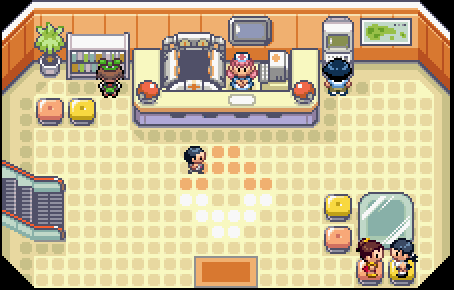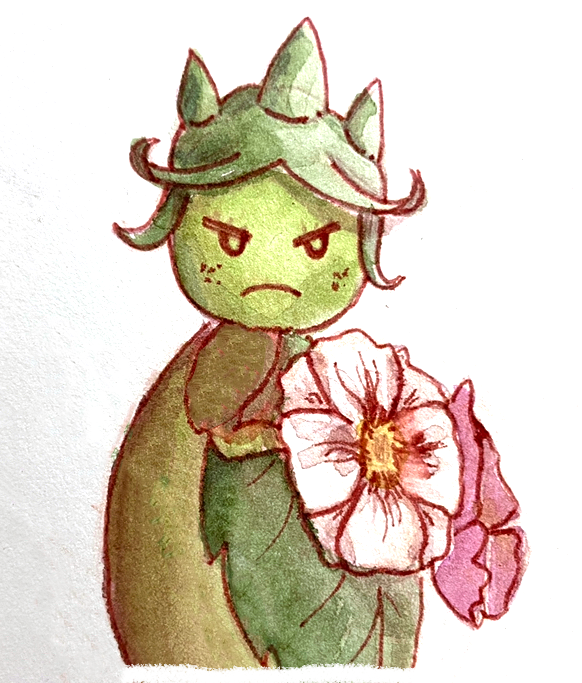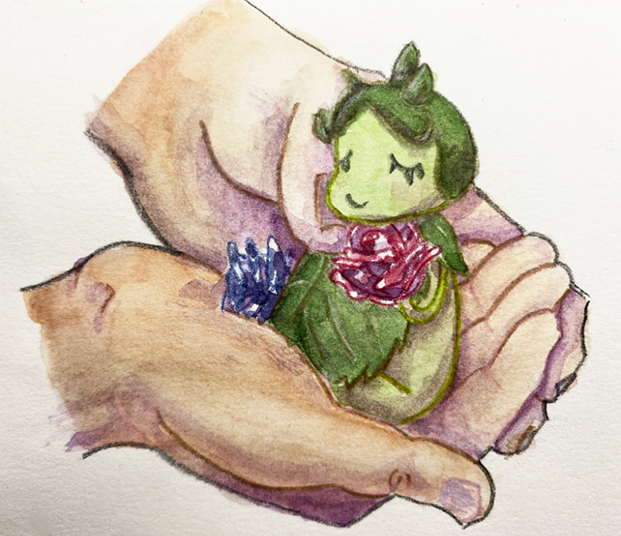You pick up a copy of Better Homes and Grass Types. The cover is rather tattered and has some dirt stains here and there -- it seems someone has really gotten some use out of it! You open to a random, dog-eared page:


You pick up a copy of Better Homes and Grass Types. The cover is rather tattered and has some dirt stains here and there -- it seems someone has really gotten some use out of it! You open to a random, dog-eared page:
Roselia are one of the most popular grass types in Hoenn and it’s not difficult to see why, considering their beautiful flowers and fragrances (not to mention their, shall we say, charmingly dramatic personalities). There's also a wide variety of breeds available that only serve to increase their appeal to breeders, trainers, contest enthusiasts, and ordinary citizens alike.

Most roselia you see in everyday life are cultivated breeds that have been genetically altered to have certain traits, like improved hardiness, more potent poisons, a wide variety of flower colors and shapes, etc. Still, some purely wild breeds exist, such as this Roselia rugosa specimen found on route 117. They tend to be distrustful of humans, though, so it's advised for ordinary citizens to keep their distance.
That said, roselia are often seen as finicky and difficult to raise; for example, many forums I visit have ended up just making a containment thread for roselia questions / complaints. I think part of the problem is that, like any other time a certain pokémon does particularly well in contests or tournaments, a thousand young or otherwise inexperienced trainers want to get one for themselves without properly researching how to care for it. And, for many of these people, it's their first grass-type pokémon ever, even! Like, obviously, a roselia is going to require much more maintenance than a treecko or some other absurdly beginner friendly species! Loves, not to put you off this wonderful pokémon or anything (I mean, I have several roselia in my garden as we speak and I love them all dearly!), but you just aren't setting yourself up for success here! Still, if you're truly dead set on raising a roselia, I suppose I can't stop you -- all I can do is hope to spread some information to combat the constant anti-grass propaganda out there, as well as help ensure the continued health and happiness of both trainer and pokémon.
So, let's start by talking about some of the eccentricities of raising grass-types. First and foremost, like most grass types, roselia prefer to spend the majority of their time rooted in soil, soaking up the sunshine. It doesn't mean they're boring or whatever else people complain about, they're just very low energy -- like cats, they'll come find you when they're ready and wanting to hang out, so don't rush them! Respect them and their boundaries and I'm sure you'll find them to be just as lovely companions as any other pokémon, if not more so. If you live in the country or have a big yard, your roselia will find a nice spot to relax on its own, but that doesn't mean they can't thrive in the city, as well. There's a flower shop just outside of Rustboro where you can find a nice selection of pots and supplemental soils, as well as pre-potted specimens. And, whether they're potted or free range, be sure to provide your roselia with a sufficient amount of water and fertilizer!

Miniature roselia are better suited for city life than other breeds.
Also, yes, it is true that grass types don't tend to like cold weather and many, including roselia, hibernate during the winter months. In fact (but don't quote me on this), I'm pretty sure the only grass type that actually thrives in icy weather is the snover line over in Sinnoh. I guess it is mildly inconvenient or whatever, but, like, is it really that much different from other environmental things you need to keep in mind? Like, no one makes a big deal about how aquatic species can only fight in water or how they can't send their charmanders out in the rain, so why does everyone complain about grass types doing planty-things?? Anyway, I digress. Dealing with this is pretty simple; you just have to be sure their bodies and roots are well insulated. Personally, I bring mine into my garage wrapped up in blankets with their pots, but you could just as well leave them out in the yard and cover them with woodchips or mulch.
Another thing that seems to scare first-timers is the prospect of deadheading their roselia. It may feel an awful lot like getting a petulant toddler to bathe (and one equipped with toxic spikes and spores, at that), but, at a certain point, you just need to put on your big kid gloves and respirator and get it done, y'know? Yes, they're unable to fight without their flowers and will likely pout and avoid you altogether for a couple of days afterwards, but, you know what? Their flowers are going to wilt anyway and, if you trim them at the first sign of brownness on the petals, they'll bloom again faster than if you just leave it be.
But, then, when fall comes around, be sure to let the flowers wither naturally to help them ease into winding down their energy for winter. It's also during this time that, depending on the breed of roselia you have, they might grow a hip or seedpod that will eventually develop into a budew. With all the crazy crossbreeding done these days, though, there's no way to tell if that budew will actually have the same type of flowers as its parent or not -- if you're looking to replicate the exact breed of roselia you have, I'd still recommend propagating them from cuttings, instead. That's how the nurseries you see popping up all over do it.
Well, I hope this brief guide was helpful to someone out there, at least! Again, my goal isn't to scare anyone away from trying to raise roselia (or grass types in general, for that matter!), I just want you to know what you're getting into. It's so annoying to go on bulbagardens, wanting to see cute pictures and, instead, just finding mountains of young kids whining and talking about pokémon that are obviously in distress due to their complete ignorance… and then they go on to blame the roselia itself for ~being difficult~ and discount an entire type of pokémon in the process, just because they aren't as easy to train as, say, bug types. Sure, they have may have a different temperament and set of needs than other types, but that doesn't mean they're any less lovable or worth raising! You just need to know what you're doing and be willing to put the work in, y'know? Justice for grass types, please!
I've been daydreaming about starting a garden for a while now, and also the more I think about grass types, the more I fall in love with them! I was looking through some PokéDex entries and a lot of grass types (especially the more planty ones) seem to mention rooting, which makes a lot of sense. I also think the idea of seasonal cycles and other environmental effects and how that effects how Pokémon is interesting to explore, as well. Might end up incorporating this headcanon into a fic at some point...
Also, hopefully this format makes sense? Initially, I was planning on going with a straight "informative" article, but then I thought it'd be really funny to write from the point of view of someone arguing with posters on a non-existent forum (bulbagardens is technically real, but they don't seem to talk about this sort of thing. i just thought it had a perfect name for this purpose) or PokéTwitter or something. (I was also kinda inspired by the classic "tired of hearing how saturn is the most fuckable planet" post, lol.) I was trying to look for toxic gardening forums for inspiration, but actually couldn't find any? On the surface, at least, all the ones I found seemed very helpful and welcoming, surprisingly.